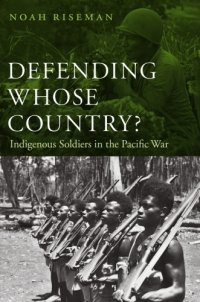
Ebook: Defending whose country?: indigenous soldiers in the Pacific war
Author: Riseman Noah J
- Tags: HISTORY--Australia & New Zealand, HISTORY--Military--World War II, World War 1939-1945, World War 1939-1945--Cryptography, World War 1939-1945--Participation Aboriginal Australian, World War 1939-1945--Participation Indian, Yolngu (Australian people)--Warfare, Navajo code talkers, Armed Forces--Aboriginal Australians, Armed Forces--Indian troops, Military participation--Indian, Cryptography, Personal narratives, Electronic books, World War 1939-1945 -- Cryptography, World War 1939-1945 -- Participation
- Year: 2012
- Publisher: University of Nebraska Press
- City: Australia;Lincoln;United States
- Language: English
- pdf
Title Page; Copyright Page; Contents; List of Illustrations; Preface; List of Abbreviations; Introduction: Reading Colonialism and Indigenous Involvement in the Second World War; 1. An Exception in the Equation? Donald Thomson and the NTSRU; 2. Allies at War: De Facto Yolngu Soldiers; 3. Black Skins, Black Work: Papuan and New Guinean Labor; 4. Guerillas for the White Men: Formal Papuan andNew Guinean Fighters; 5. The Navajo Code Talkers: Warriors for the Settler Nation; 6. When the War Was Over: Forgetting and (Re)membering the Code Talkers; Conclusion: The Soldier-Warrior in Modern War.;"In the campaign against Japan in the Pacific during the Second World War, the armed forces of the United States, Australia, and the Australian colonies of Papua and New Guinea made use of indigenous peoples in new capacities. The United States had long used American Indians as soldiers and scouts in frontier conflicts and in wars with other nations. With the advent of the Navajo Code Talkers in the Pacific theater, Native servicemen were now being employed for contributions that were unique to their Native cultures. In contrast, Australia, Papua, and New Guinea had long attempted to keep indigenous peoples out of the armed forces altogether. With the threat of Japanese invasion, however, they began to bring indigenous peoples into the military as guerilla patrollers, coastwatchers, and regular soldiers. Defending Whose Country? is a comparative study of the military participation of Papua New Guineans, Yolngu, and Navajos in the Pacific War. In examining the decisions of state and military leaders to bring indigenous peoples into military service, as well as the decisions of indigenous individuals to serve in the armed forces, Noah Riseman reconsiders the impact of the largely forgotten contributions of indigenous soldiers in the Second World War."--Project Muse.
Download the book Defending whose country?: indigenous soldiers in the Pacific war for free or read online
Continue reading on any device:

Last viewed books
Related books
{related-news}
Comments (0)